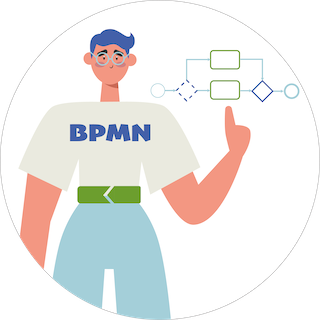
Modeling Business Processes
First things first, what is a business process?
A business process is an activity or set of activities that accomplish a specific organizational goal. As you can imagine, business processes are everywhere. They can be diverse and span various areas of your organization, such as sales, marketing, finance, human resources, procurement, customer service. When those business processes are clearly described, teams, departments, and management are aligned and work gets done in an optimal manner. It is therefore essential for organizations to understand and map those processes in a structured manner.
Enter BPMN
BPMN isn’t new. It was first introduced in 2004 by the Business Process Management Initiative (BPMI) and has since been widely used by both business and technical professionals to model and implement business processes. BPMN stands for Business Process Model and Notation. Its current version is BPMN 2.0. It’s a standardized graphical language used to describe and represent business processes. It provides a way to visually illustrate the different steps, activities, and interactions that occur within an organization to achieve a specific outcome or deliver a particular service.
“If you can’t model it, you can’t improve it”
You may know the famous quote attributed to Peter Drucker "If you can't measure it, you can't improve it." In the context of our business process topic, we could easily transpose it to: “If you can’t model it, you can’t improve it”. Indeed, to improve a process, it's important to first reflect on exactly what that process entails. The visual representation of processes makes it easier for all stakeholders to understand and align on process-related initiatives. This understanding makes it easier to identify areas for improvement, respond to changing market dynamics, and adapt to evolving customer demands. BPMN's visual nature facilitates process agility and flexibility, allowing organizations to quickly reconfigure or redesign processes as needed.
The holy grail of business efficiency
Visualizing business processes as BPMN diagrams, can help sorganizations identify bottlenecks and streamline workflows. This in turn leads to improving process efficiency, reducing costs, and enhancing productivity. Further more, BPMN serves as a blueprint for process automation initiatives. By using BPMN diagrams, organizations can design automated workflows, eliminating manual and repetitive tasks.
Compliance and Risk Management
BPMN allows organizations to incorporate compliance requirements and controls into their process models. By ensuring that processes adhere to regulatory standards and internal policies, organizations can mitigate compliance risks. A strong compliance framework built using BPMN can provide a competitive advantage by enhancing trust, reputation, and credibility in the marketplace.

The need for BPMN skills
Now how do get to realize all those key benefits? There is a need for individuals to have skills in BPMN, especially for those involved in business process analysis, design, improvement, and automation. BPMN serves as a bridge between the business perspective and the technical implementation, supporting process design and optimisation, effective collaboration and alignment, compliance and governance, and ongoing process improvement in the context of automation.

Do you “speak” BPMN?
Are you interested in becoming BPMN-skilled? Take a look at processCentric’s BPMN training offering. By combining self-paced online learning with interactive face-to-face (or virtual) sessions, you and your colleagues can become familiar with BPMN 2.0 elements in the most efficient way possible and apply this skill immediately in your organization to create easily readable and comprehensible business process models.
The course “BPMN 2.0 Descriptive Modeling” presents the Descriptive modeling subclass of BPMN 2.0 (Level 1), which covers is a range of elements and symbols largely carried over from traditional flowcharting.
- The course “BPMN 2.0 Analytical Modeling” presents the Analytic modeling subclass of BPMN 2.0 (Level 2), which expands the range to be able to describe event-triggered behavior, critical to modeling exception handling and other elements such as data collection or data input object.
The course “BPMN 2.0 Executable Modeling” (Level 3) (soon to be available) covers additional notions that allow you to make your processes executable on a BPMN engine.
